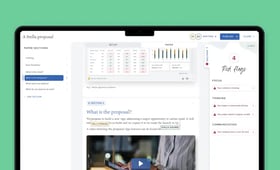Key takeaways
- Ease of use matters more than advanced functionality when supporting non-technical board members.
- Look for intuitive navigation, secure access, and tools that reduce meeting prep time.
- Board portals should support both in-person and remote meetings with minimal training.
- The right software improves board performance by freeing directors to focus on strategy, not admin.
Why does ease of use matter in board portals?
Ease of use matters in board portals because busy directors don’t have time to wrestle with clunky software. If the platform is intuitive, they adopt it quickly, prepare more efficiently as documents, discussions, and decisions are simple to access and manage. The right platform also reduces the support burden on company secretaries and governance professionals.
- Faster adoption: Intuitive design means directors can start using the portal with little to no training.
- Better meeting prep: Easy navigation and smart tools cut down the time spent on admin.
- Higher engagement: When access is seamless, directors are more likely to review materials and contribute meaningfully.
- Stronger focus on strategy: With tech out of the way, boards can spend their energy on decisions that drive impact.
“The Board Intelligence board portal could not be more intuitive. Everybody loves using it, and we’ve saved so much time since switching.”
Jason Wright, Society Secretary, Nationwide - read the case study.

What are the key features non-technical users need most?
When evaluating board management software, focus on features that genuinely reduce complexity:
- Single, secure access point: A central hub for board papers, agendas, and minutes.
- Simple navigation: Search functions, annotations, and cross-referencing that require no training.
- Offline access: Directors can review packs on planes, trains, or in areas with poor connectivity.
- Seamless meeting integration: Video conferencing built in, so virtual meetings run smoothly.
- Smart collaboration tools: Note-sharing, Q&A, and secure messaging between members.
- E-signatures: Quick approvals without chasing paper or multiple platforms.
What are the top board management software options?
Some solutions are overly complex and packed with technical features, but they are difficult for non-technical users to navigate. They often leave directors frustrated, reliant on IT support, and wasting time trying to get the basics done.
Board Intelligence takes a different approach. Based on two decades of experience, our modern, user-friendly platforms offer intuitive design and advanced features, but are simple enough for any board member to use without training.
Tip: Read Why your board needs a board portal instead of another collaboration tool for more expert insights.
Here’s a look at two of our star platforms, and how they shape up against the competition.
Board Intelligence
A user-friendly board portal must combine intuitive navigation, clear document management, and straightforward meeting tools with secure access, customizable reporting, and insight-driven agendas. Let’s see what Board Intelligence offers.

Board Intelligence board portal
The Board Intelligence portal is built with simplicity at its core. Non-technical directors can log in securely with FaceID or TouchID and access all their board materials in one place. Split-screen functionality makes it easy to follow the pack while participating in a virtual meeting, and annotations sync across devices without any learning curve.
For governance professionals, smart agenda planners, drag-and-drop file management, and instant republishing of amended papers save hours of preparation time. The result is a tool that feels natural for non-technical members while transforming efficiency behind the scenes.
And we have receipts: 52% of boards now use secure portals for materials, up from 40% in 2020. Based on our board reporting self-assessment data, this shows a clear move away from legacy tools.
“It took me 5 minutes to understand how to use the Board Intelligence Portal — it couldn’t be easier.”
Matthew Parker, CEO, Babble
Lucia: AI-Powered Reporting
While portals solve the “where” of board information, reporting toolkits solve the “what”.
Lucia, Board Intelligence’s AI-powered board reporting software, goes beyond document management. It acts as a real-time “critical friend” for report writers, guiding them to cut jargon, sharpen analysis, and focus on what matters most.
For non-technical directors, this means the materials they receive are structured, clear, and accessible. Gone are the days when packs were over 200 pages long and filled with clutter.
Lucia’s structured approach gives directors confidence that they’re working with high-quality information, making their job easier and their discussions sharper.
Other leading platforms ideal for non-techies
Simplicity should never come at the expense of strategic functionality. Platforms like the ones we list below offer approachable interfaces, but can they pair ease of use with advanced analytics and strategic guidance?
Easy Board
Easy Board is often praised for its simplicity. With features like “Magic Links,” users can access board documents without logging in. It supports polls, meeting scheduling, and a clean document search, all wrapped in a friendly interface.
That said, robust features like deep analytics, advanced permissions, or customizable workflows are minimal, limiting their usefulness.
Board Intelligence has designed a board portal that allows large or complex boards to maintain strategic oversight without sacrificing ease of use.
BoardPro
BoardPro is designed with ease of use in mind, particularly for small organizations and nonprofits. It offers intuitive agenda creation, straightforward minutes tracking, and simple action item management.
Yet its streamlined functionality lacks advanced reporting, templated board packs, and strategic frameworks, which can limit its usefulness in complex governance settings.
The Lucia management reporting software from Board Intelligence embeds strategic insights and question-led board packs directly into the platform. This gives non-technical users the ability to contribute meaningfully to high-level discussions.
iBabs
iBabs is known for its high usability and clean navigation. The platform delivers strong document management and good support, often praised for offering more functionality than some enterprise-focused alternatives.
The downside is that, when boards need advanced governance tools like customizable reporting templates, analytics dashboards, or insight-driven agendas, iBabs can feel limited.
Board Intelligence offers a user-friendly interface with features that make complex governance accessible to all users.
BoardPAC
BoardPAC delivers a smooth, clean interface tailored for ease of use, with features like document sharing, meeting automation, and strong customer support. Some users, however, report slow performance and limited advanced functionalities, which can hinder large boards or highly regulated organizations.
Board Intelligence, in contrast, provides fast, scalable performance along with advanced features such as audit trails, secure access management, and strategic analytics. The portal's ease of use is designed to support board effectiveness.
How do you choose the right platform?
Choosing the right platform is less about feature checklists and more about fit. Ask:
- Does the software reduce complexity for non-technical users?
- How much time will it save governance teams in preparing board packs?
- Is support available 24/7, and does it include training resources?
- Can the tool scale as your organization grows or your board’s needs evolve?
For many boards, the balance is clear: simplicity drives adoption. A platform that saves time and builds confidence ultimately results in boards that can fully deliver on their potential.
With Report Writer, you can go from blank page to ready-to-share paper in a blink, with the help of AI built on 20 years of report writing expertise.
See report writerFAQs
What features make board management software intuitive for non-technical members?
Intuitive navigation, offline access, secure login, collaboration tools, and e-signatures are essential. These features let directors work effectively without technical training.
How does intuitive board management software improve board performance?
By reducing administrative friction, software frees directors to focus on strategy and decision-making. This improves meeting efficiency, reduces wasted time, and strengthens board discussions.
Is intuitive board management software suitable for different types of organizations?
Yes, intuitive board management software is suitable for a variety of organizations, including large corporations, SMEs, and nonprofits across a wide range of sectors. The software offers scalability so it can adapt as a business’s needs change and grow.
What should boards consider when choosing intuitive board management software?
Ease of use, security certifications, integration with meeting tools, and the quality of support should be top of the list. Boards should also consider cost-effectiveness and the ability to handle last-minute changes.
How can organizations successfully implement intuitive board management software?
Start with pilot groups, provide training where needed, and use built-in support resources. Adoption is strongest when directors see immediate time savings and improved access to materials.



